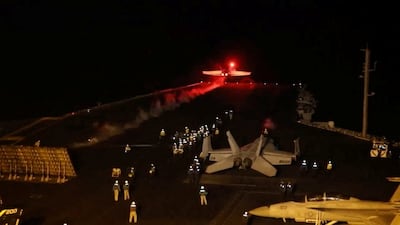The US and UK are prepared for retaliatory attacks after launching air strikes on Houthi rebel positions in Yemen that are expected to diminish the group's capabilities, a senior US administration official said on Thursday.
The strikes destroyed several targets controlled by the Iran-backed militants, the official said. The military action was conducted along with “non-operational support” from Australia, Canada, the Netherlands and Bahrain.
“The US and UK forces that participated in these strikes remain well prepared to defend themselves, as well to continue to contribute to the defence of maritime traffic and other military vessels as part of the coalition in the Red Sea,” the official said.
US officials on Wednesday warned the Houthis faced consequences after a drone and missile attack in the Red Sea.
Houthi drones and missiles were launched in salvos directly against US ships on Tuesday, the official said.
Thursday's strikes were aimed at “disrupting and degrading” the group's capabilities to threaten global trade and freedom of navigation in one of the world's most important waterways, the US official said.
“This collective response follows one of the largest Houthi attacks in the Red Sea to date earlier this week,” a senior military official added.
The US official said the targets of Thursday's strikes related to the group's missile, radar and UAV capabilities – essential to its campaign against commercial shipping in international waters.
The Houthis began attacking vessels in the Red Sea in November, as a response to Israel's war in Gaza.
The Pentagon in December established an international task force called Operation Prosperity Guardian to counter the attacks.
Thursday's strikes showed a shared commitment to freedom of navigation, international commerce and defending mariners from attacks, 10 countries said in a joint statement.
“Our aim remains to de-escalate tensions and restore stability in the Red Sea, but let our message be clear: we will not hesitate to defend lives and protect the free flow of commerce in one of the world’s most critical waterways in the face of continued threats,” it read.
The joint statement was signed by countries including the US, UK, Australia, Bahrain, Canada and Germany.
Since mid-November, there have been more than two dozen attacks on commercial vessels, it read.
The Houthis said they were targeting Israeli ships, or those bound for Israel, and attacks would continue until the country stopped its bombardment of Gaza.
The Houthi attacks disrupted commercial traffic in one of the world's busiest maritime routes, which accounts for about 15 per cent of international trade.
“The Houthis claim their attacks on military and civilian vessels are somehow tied to the ongoing conflict in Gaza. That is completely baseless and illegitimate,” the administration official said.
“They are firing indiscriminately on vessels with global ties – most of the ships that have come under attack have nothing whatsoever to do with this Israel.
“There's no justification for these illegal attacks in international waterways.”
The attacks, US officials say, have directly affected the cargo and commercial interests of more than 50 countries.
More than a dozen shipping companies have rerouted vessels around the Cape of Good Hope in South Africa, officials said. The move has increased shipping and insurance costs and affected the global economy.
The UN Security Council passed a resolution on Wednesday condemning the attacks and demanding their immediate halt.


